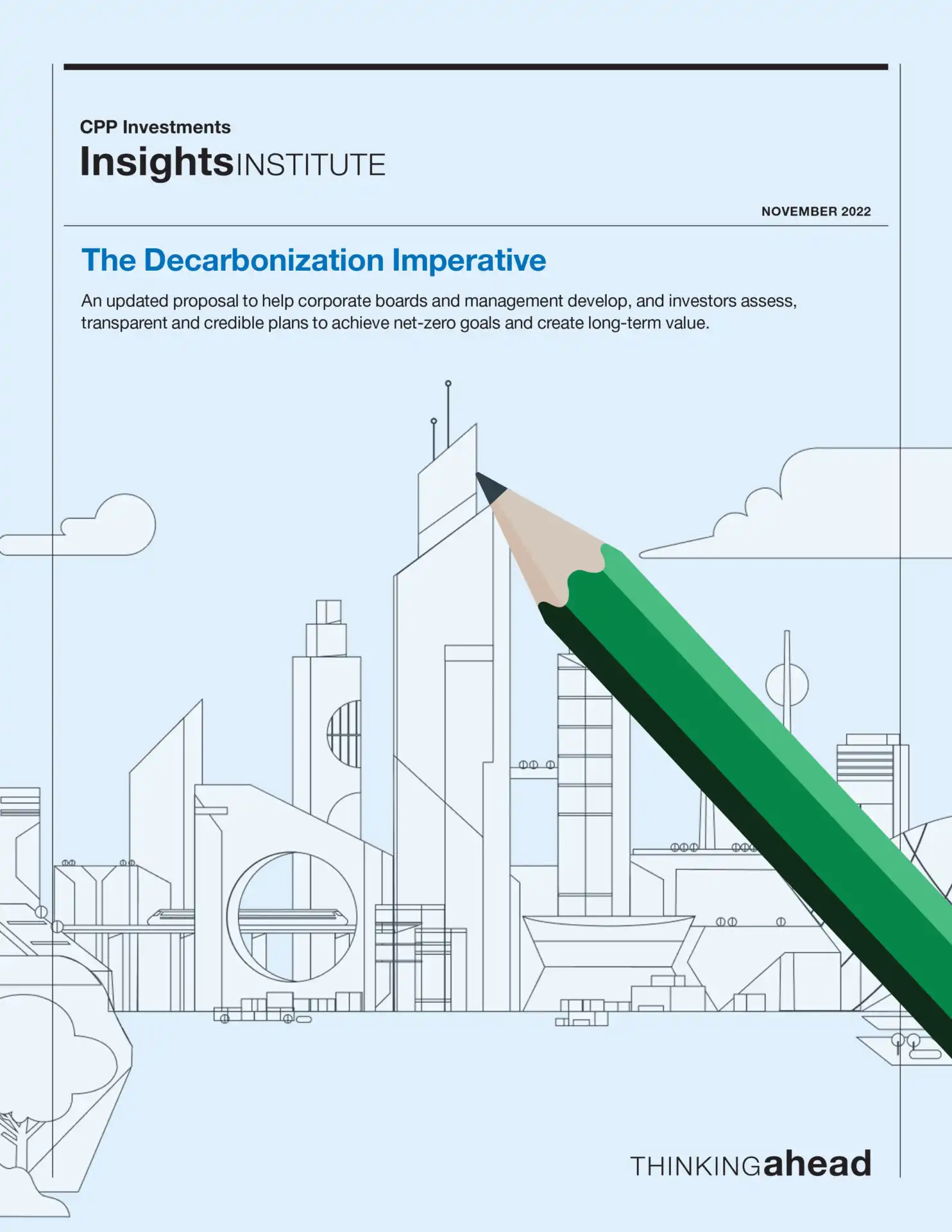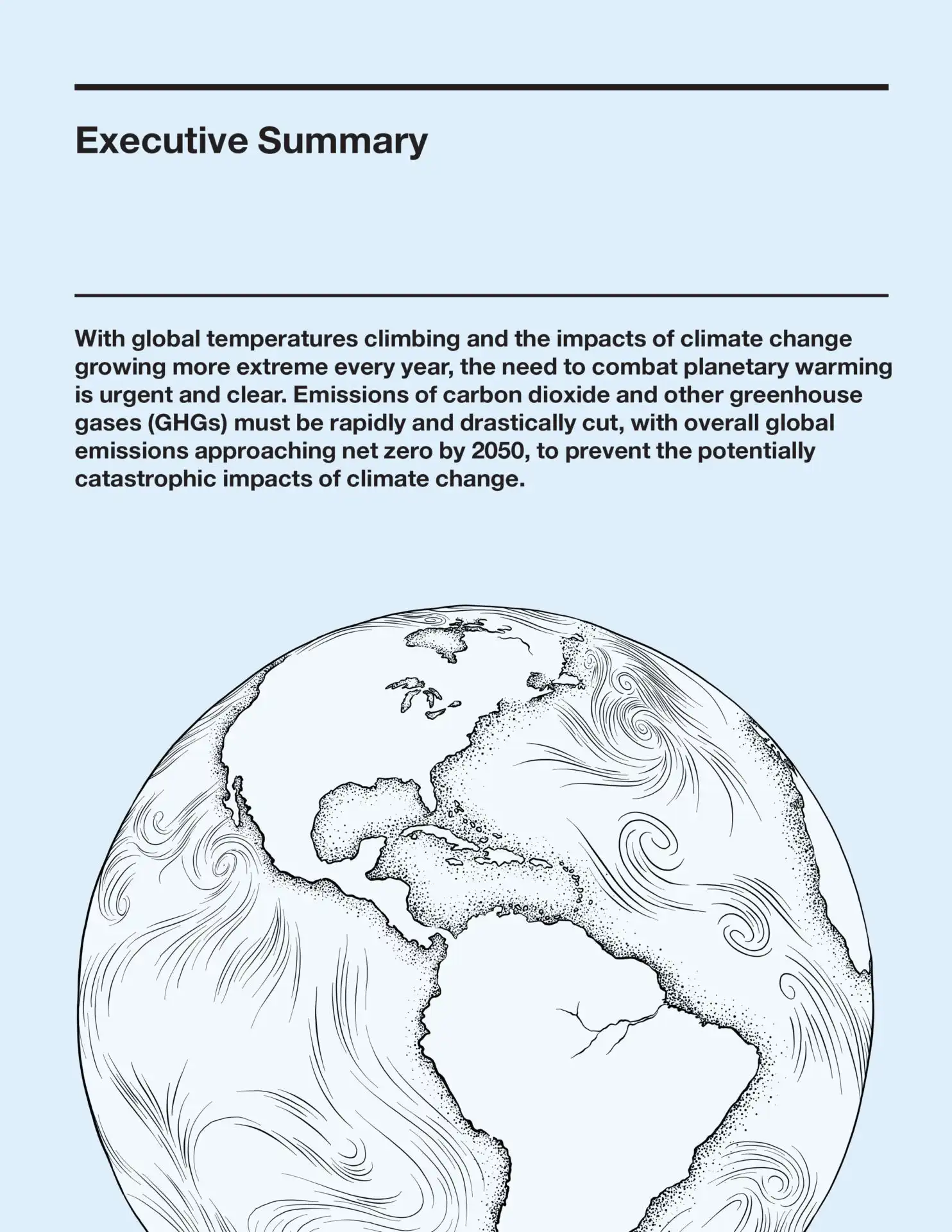
Executive summary
With global temperatures climbing and the impacts of climate change growing more extreme every year, the need to combat planetary warming is urgent and clear. Emissions of carbon dioxide and other greenhouse gases (GHGs) must be rapidly and drastically cut, with overall global emissions approaching net zero by 2050, to prevent the potentially catastrophic impacts of climate change.
This rapid decarbonization will require sweeping changes, transforming every sector in every country. Industrial processes that can’t be decarbonized may disappear. Business models will evolve across the whole economy, not just within energy systems. Everything from industrial processes, buildings, transportation, food and consumer goods will be impacted. Without dramatic improvements in solutions to deliver low- or no-carbon hydrocarbons or reduction in the cost of carbon capture technologies that can offset GHG emissions, fossil fuel reserves risk becoming stranded and potentially requiring a write down in value. At the same time, the need to decarbonize is already creating a myriad of new opportunities, stimulating a powerful new wave of innovation that is rapidly bringing down the costs of many low-carbon technologies, while creating new technologies and business.
It is not enough for companies to identify their capacity to economically abate emissions. Doing so must be among their most urgent priorities.
Companies face the same increasingly severe physical impacts of climate change, such as more extreme floods, droughts, and heatwaves, as their stakeholders. In addition, they are under growing pressure from investors, regulators, suppliers, customers, and competitors to reduce their emissions, to disclose their climate and financial risks, and to create viable plans to transition to a low-carbon economy. They are grappling with technological uncertainties, including future changes in regulation, carbon prices and cost of alternative technologies, and the challenge of acting when data are incomplete or lacking. That lack of data is hobbling efforts to accelerate the transition to a low-carbon economy.
Until companies make detailed disclosures and develop decarbonization plans based on clear and objective data, investors and markets will find it difficult to accurately value companies or predict their future performance. Equally important, companies that do not have decarbonization plans are likely to miss key opportunities to maximize long-term returns and gain competitive advantages by finding efficient transition paths ahead of the competition. Thousands of companies globally have already committed to net zero, but in many cases, it is unclear whether these companies have credible plans for achieving their commitments.
Many companies have already taken constructive action, backing up their pledges to cut emissions with investments in renewable energy, cuts in operational emissions, and other vital steps. During recent discussions at the CPP Investments Insights Institute, which brought together other asset owners, asset managers, accountants, academics, consultants, and index providers, we found widespread agreement on a fundamental issue: there is insufficient information available to determine the ability of most companies to transition to a low-carbon future.
Some companies have made commitments to net-zero emissions without clear pathways to achieve those goals, putting them at risk of negative market reactions when investors realize the goals are not achievable. Others have yet to even create a governance framework to address the issue or assess their current GHG emissions, the essential first steps to decarbonization and sustainability according to the Task Force on Climate-related Financial Disclosures (TCFD).
These failures expose companies to a number of risks, including higher energy costs, higher costs of capital, and market share losses to more climate-aware competitors. They also risk impaired future competitiveness as the transition to a low-carbon future progresses, greater potential for being burdened with stranded assets, failure to spot new business opportunities, and potential litigation if their climate guidance is discovered to have been made without an appropriate basis.
To address these issues and to encourage more companies to take action, last year CPP Investments proposed a broad Abatement Capacity Assessment Framework (‘Framework’) and standardized template for assessing a company’s potential for reducing emissions. The idea is conceptually simple. First, determine a company’s current baseline emissions. Second, identify actions that can cost-effectively cut emissions now (the current “abatement capacity”). And third, assess steps and strategies that can cost-effectively reduce emissions in the future under different carbon price assumptions (the “projected abatement capacity”).
The Framework serves as a starting point for the development of transition plans and determining their economic feasibility. Additionally, the Framework would enable companies to comply with the sustainability reporting standards currently being developed based on recommendations from the TCFD, while also meeting the demands of shareholders and other investors for climate-related disclosures.
Since we proposed the Framework, we conducted a successful pilot with one of our portfolio companies, with encouraging and informative results. In addition, via the CPP Investments Insights Institute, we have brought together roundtables of asset managers, consultants, and accountants to explore the strengths and possible limitations of the Framework. We are in the process of conducting several other pilots and assessing our own internal operations using the Framework, as part of our commitment to bringing our portfolio and operations to being net zero by 2050.
Meanwhile, the regulatory landscape is changing. Both the United States Securities and Exchange Commission (SEC) and the Canadian Securities Administrators (CSA) have proposed mandatory reporting requirements for GHG emissions, emissions-reduction targets, exposure to climate hazards and financial risks, and transition plans. In addition, the International Sustainability Standards Board is developing climate standards that are expected to become a global baseline for reporting on climate-related issues.
This confirms the role we see for the proposed Framework. In June 2022, we provided comments to the SEC in response to its proposed rules to enhance and standardize Climate-Related Disclosures for Investors. In our comments, we note that rather than needing to be used as a standalone separate exercise, the Framework can complement and support the coming regulations by offering a roadmap for the work needed to meet those requirements. In particular, the Framework provides an approach for reporting on the economic feasibility of delivering on companies’ emissions reduction commitments without giving away any competitive secrets. Supporters of the Framework also believe it can elicit information that the market can utilize to drive fundamental changes in the economy across industries and countries, and perhaps help guide the regulations themselves. We believe that market actors, especially capital providers, will want to advocate for the kind of rigor and transparency this Framework represents. As regulators put rules in place, it is in the best interest of investors and their beneficiaries that these rules provide decision-useful insights both to price risk and to ensure capital is allocated to support the transition.
Our overall message remains clear as outlined in our original ‘The Future of Climate Change Transition Reporting’ report. Climate change—and the resulting need to rapidly cut emissions and prepare for the coming transition—is an urgent issue that requires immediate attention from corporate boards and senior executives. They will need to ensure they have the necessary resources to develop and share their transition plans. This includes increasing the company’s climate literacy, using the Framework to quantify the company’s decarbonization capacity, and prioritizing the removal of emissions where economically possible, while simultaneously developing strategies for abating those emissions that are currently more costly to abate. Failure to focus on decarbonization as a core function of management and business strategy means boards and management are not acting in the best interests of their companies, shareholders, and other stakeholders.
Developing and assessing the viability of decarbonization and transition plans should not be viewed as an onerous new exercise. Instead, companies should embrace the process as a key mechanism for identifying major opportunities and gaining competitive advantages. Assessing a company’s abatement capacity enables its management and board of directors to better understand how it can benefit from “greener” and more efficient technologies, and to accelerate the development of new low-carbon technologies. The Framework helps companies build businesses focused on the long term, gain market share over competitors with higher carbon intensities, prove to investors they can survive and thrive in a low-carbon world, maximize their own long-term returns, and help accelerate the economy-wide transition to net zero. In addition, the Framework enables companies to share the underlying assumptions for their net-zero commitments in a transparent manner without compromising commercially sensitive data.
Introduction
A year ago, the CPP Investments Insights Institute proposed a broad Abatement Capacity Assessment Framework (‘Framework’) and standardized template for companies to identify and report all sources of greenhouse gas (GHG) emissions in their operations and supply chains, and to calculate the economic viability of mitigating those emissions under different carbon price scenarios. There has been strong public and private sector interest in and reaction to the Framework.
Over the intervening months, we have sought feedback from other institutional investors, auditors, accountants, academics, private equity general partners, and consultants to better understand any concerns and make refinements. CPP Investments is also conducting ongoing pilot assessments to prove that the approach can successfully identify major opportunities to cost-effectively reduce emissions and provide important data to boards and investors as they allocate their resources.
These conversations and pilots have reinforced our belief in the need for a consistent, rigorous, and transparent way for companies to calculate and report their transition risks, and more specifically, their ability to meet their net-zero goals. We see the Framework as a valuable addition and complement to climate disclosure rules that have recently been proposed by national and international financial regulatory bodies. We strongly urge directors and executives to use such emissions-reduction assessments as a core part of a company’s business strategies.
Furthermore, we believe that as climate-related regulations come into focus, market actors, especially capital providers, will require the kind of rigor and transparency this Framework represents. As regulators put rules in place, it is in the best interests of investors and their beneficiaries that the transition to a green economy be guided by transparent reporting. Our Framework offers a mechanism to develop and present those metrics.
Wake-up call: The whole economy transition to net zero is underway. Is your company ready?
It is difficult to overstate the urgency of reducing GHG emissions—and the sweeping changes that such a transition will bring for the economy and humanity. The planet has already warmed more than 1°C since pre-industrial days.
Without rapid and substantial cuts in emissions of heat-trapping gases, the increase will climb to 1.5°C (2.7°F) between 2030 and 2052. Each year, the toll from the impacts of climate change, such as more severe storms and floods, and searing heatwaves and droughts, adds up to billions of dollars in damages and incalculable human suffering.
According to the Intergovernmental Panel on Climate Change we have three years before it is crucial to reach the peak in global GHG emissions and start a rapid decline if we are to limit warming to around 1.5°C. As a result, directors and executives should already be planning now for the coming low-carbon global economy.
There is no mystery about what needs to be done. Report after report, from organizations like the International Renewable Energy Agency and the Risky Business Project, show that successful decarbonization of the energy system rests on three pillars: 1) dramatically boost energy efficiency; 2) produce that electricity from zero-carbon emissions sources, like wind, solar, hydro, nuclear, and geothermal; and 3) electrify everything possible, from transportation to heating and cooling systems in buildings. Additionally, viable strategies are being proposed for sectors and industries that are difficult to electrify directly, such as steel, chemicals, cement, and shipping. For those industries, fuels or feedstocks could be produced from renewable electricity (for example, in the case of hydrogen or ammonia) or hydrocarbons will continue to play an important role if accompanied by carbon capture or removal technologies. Furthermore, low-carbon strategies must be adopted in food systems and other sectors.
Governments around the world have recognized the need to decarbonize and continue to move their economies towards net zero through their Nationally Determined Contributions, which are expected to be tightened further to meet the 1.5°C target. As a result, companies operating in this landscape will increasingly be required to decarbonize. Against this backdrop, we believe that boards have a responsibility to see that management teams have appropriately considered and integrated a strategy to decarbonize their businesses. The proposed Framework allows boards to better understand the levers available to their companies to decarbonize and measure progress against them—while avoiding a collision course with future regulation.
As the world transitions to net zero, we believe there will be investment opportunities across sectors, asset classes, and geographies. Those opportunities are likely to come from industry leaders that drive carbon reduction innovations and practices. For example, today’s engine block or fuel injector manufacturers will become tomorrow’s equivalent of buggy whip makers from a century ago, unless they can use their technical expertise to produce electric motors, chargers, or other green economy essentials. Gas-fired boilers will be overtaken by efficient heat pumps. Similarly, there could be declines in a wide variety of factories and facilities supplying the fossil-fuel-based economy. Meanwhile, suppliers of the indispensable solutions for the coming low-carbon economy, including alternative proteins, will likely climb in value.
CPP Investments believes that companies driving and demonstrating carbon reduction innovations and practices will generate maximized returns. These returns could come from increased efficiency and renewable energy to carbon capture and storage technologies, or sustainable food, real estate, or transportation. These are companies that are not only supporting their own transitions but also those of the value chains in which they function. CPP Investments is catalyzing these transitions by investing in companies at varying stages of the decarbonization spectrum. Through incentivization and capitalization, the Fund’s decarbonization investment approach enhances value to the Fund and transforms businesses.
– Financial services consultant
Navigating this far-reaching transition continues to be a huge challenge for companies—and their investors. Companies may need to adjust or even exit some businesses and enter new ones, phase out product lines, invest in new technologies, depreciate some assets faster, revamp supply chains, or even relocate facilities closer to sources of renewably-produced energy or low-carbon fuels. The transition will also be a challenge for capital providers. To funnel capital to the highest-return opportunities, investors need a way to assess which companies can profitably mitigate emissions by upgrading to new technologies and fuel sources—and which are incapable of cutting their emissions under any foreseeable scenario.
Yet, roundtable discussions, convened by the CPP Investments Insights Institute with asset managers, accountants, and consultants, found that many companies lag in understanding and planning for these changes. As one consultant says: “A lot of sectors are going to fundamentally change. But a lot of companies don’t understand the system shifts.”
– Accountant
In fairness, predicting the future is notoriously difficult, especially during major transitions. The lessons from the past are that many innovations and new technologies—and their impacts—are completely unexpected, and that costs typically decline much faster than originally estimated. In fact, even the most optimistic recent predictions for price drops and investment growth in green technologies like solar PV, wind energy, and battery storage have significantly underestimated the actual pace of change.
Why an Abatement Capacity Assessment Framework is essential
In February 2022, CPP Investments committed its portfolio and operations to being net zero of GHG emissions across all scopes by 2050.
The commitment is made on the basis and with the expectation that the global community’s ability to achieve net zero is contingent on several advancements. These advancements include the acceleration and fulfilment of commitments made by governments, technological progress, fulfilment of corporate targets, changes in consumer and corporate behaviours, and development of global reporting standards and carbon markets, all of which will be necessary for us to meet our commitment.
While cutting emissions and creating transition plans are difficult tasks, our discussions with asset owners and asset managers (representing a total of over US$18 trillion in assets under management) as well as accountants and consultants show that most companies and their boards of directors have yet to begin grappling with the challenge. By failing to see the urgency of decarbonization, they are putting their companies at risk.
While many companies have made commitments to net-zero emissions, some have done so without credible plans for achieving those goals. One recent study analyzed sustainability reports and other publicly available documents from 25 prominent businesses that have set net-zero targets.1
– Financial services advisor
The analysis showed that the plans these companies have in place would achieve emissions cuts of only 40%, not 100%. The failure of these companies to back up their commitments with realizable emissions-reductions paths puts them at risk of negative market reactions when the targets are not met.1 The sustainability-related setbacks companies can experience today highlight the importance of open dialogue and strong partnership. The type of partnership where capital providers are willing and able to take the long view, and actively create an environment where solutions can take shape in businesses.
We believe the Framework provides one such solution. It is a mechanism for helping companies take the first steps in assessing their capacity for reducing emissions. It also provides incentives for developing both decarbonization technologies and rigorous methods to ensure the quality of carbon capture projects.
– Global asset manager
The Framework is analogous to mapping a trip with GPS. It showcases the “routes” to decarbonization, the shortcuts for reaching the destination (by highlighting the most efficient actions and sequence) as well as the tolls and fees along the way (by showing the tradeoffs between speed and costs). It also lets others, such as investors, track progress along the route. This supplements the Science Based Targets Initiative’s (SBTi) Target Validation Protocol. The SBTi protocol validates the destination and the timeline, rather than actually charting the specific route and associated cost for getting there. While both approaches are important, the purpose of the Framework is to provide actionable guidance at a company level for which actions to take, in which order.
The Framework has three basic steps (for more details and template, please see Appendix):
01
Determine the Current (Proven) Projected Abatement Capacity.
When assessing its capacity to abate GHG emissions, the critical first step for a company is to add up its current emissions and estimate how much of those emissions are economic to abate (see box for definition) with currently available, proven economic technologies.
For example, a cement plant may be able to eliminate 100% of emissions associated with its electricity consumption by switching to renewable electricity, but most of the emissions from its kilns cannot be reduced cost-effectively with the technologies currently available. The analysis would cover both direct emissions from company operations and assets (referred to as Scope 1 emissions) and emissions from the generation of energy the company uses (Scope 2). Similar abatement capacity assessments could be done for other aspects of a company’s operations (including business travel), suppliers, and customers (Scope 3), resulting in an auditable metric that sums up its current capacity to abate. Scope 3 emissions are the most challenging for companies to assess since their inclusion would require suppliers and customers to provide abatement capacity assessments for their own Scopes 1 and 2 emissions. This is especially challenging across complex supply chains.
Methods for assessing Scope 3 emissions, while avoiding double counting and ensuring the integrity of the data, are still embryonic. Until this is resolved, we believe companies should prioritize assessing their Scopes 1 and 2 emissions.
Definition of “economic to abate”
02
Assess the Long-term (Probable) Projected Abatement Capacity.
The uncertainties associated with technology costs, the pace of innovation, regulatory regimes, and carbon prices make it difficult to standardize methods of assessing future abatement capacity. To cope with this complexity, we propose that companies assume no change to today’s technology costs and regulations, but use standardized carbon prices that are higher than current levels.
Our original Framework used US$75 and US$150 per metric ton of carbon dioxide equivalent (tCO2e) to create two scenarios for determining future abatement capacity. To be meaningful in making real world decisions, the price of carbon in the initial assessment needs to be above the current highest spot price, which reached €99/tCO2e in the European Union in early August. So, we are updating the carbon price in this Framework to be US$100 and US$150 per tCO2e. The US$100 per tCO2e carbon price allows companies to report their incremental capacity to abate over the spot price. Meanwhile, a price of US$150/tCO2e is widely seen as necessary to create large enough incentives to decarbonize the whole global economy. The use of a carbon price of US$150/tCO2e, which currently may seem high, could provide additional visibility on the ability of companies to further abate their emissions.
However, in addition to these carbon prices, companies could also consider using internal shadow prices that they would select based on their own unique situations.
The calculated economic abatement capacities using these carbon prices would be subject to revision as regulations advance or technology costs fall. As a result, this future abatement capacity assessment would need to be done periodically, ideally annually.
03
Determine the Uneconomic Projected Abatement Capacity.
CPP Investments believes that the Framework will enable companies to identify opportunities to cut emissions. Some may even find that emissions can be cost-effectively brought down to net zero at various prices of carbon. However, others will find that some emissions are uneconomic, or even technologically impossible, to eliminate. Those residual emissions could then be reported along with management’s assumptions on how they will eventually address the issues. Possible strategies could include the managed decline or shuttering of business activities (such as closing coal mines), relying on further technology development (such as synthetic fuels), or purchasing high quality, carbon removal credits that are additional, verifiable and permanent.

Lessons from applying the Abatement Capacity Assessment Framework
To determine the feasibility of the Framework and encourage its broader implementation, CPP Investments is testing its use with select companies in its active portfolio and in its own operations.
The Framework plays an important role in the CPP Investments’ decarbonization investment approach. This unique approach focuses on financing emissions reductions and partnering with select high emitters to spur meaningful and necessary progress to net zero in the real economy. In doing so, we benefit from the value produced by the transition. The Framework is one of the tools that the Fund will use to employ and scale this approach. The first pilot assessment was conducted on the Trafford Centre, a shopping centre on the outskirts of Manchester, England, which has foot traffic of more than 35 million visits a year. The largest mall in the U.K. when it opened in 1998, the Trafford Centre went through several changes in ownership before being acquired by CPP Investments’ Real Assets Credit Group in December 2020. It is now part of CPP Investments’ real estate portfolio.
Click here to hear from Fraser Pearce, the Trafford Centre’s independent board chair, about the board’s experience utilizing the Framework to help inform the company’s path to net zero.
The Framework helped provide management with the Centre’s baseline emissions. The data revealed significant opportunities to cost-effectively reduce most of the Centre’s emissions, with a big chunk coming at a surprisingly low cost (see box). The exercise also charted possible pathways to reducing the remaining emissions and achieving net zero. CPP Investments has provided a description of this case study for inclusion in the 2022 Task Force on Climate-related Financial Disclosures (TCFD) Status Report.
The next five pilots of the Fund’s decarbonization investment approach (employing this Framework) were still ongoing when this report was finalized. These pilots are expected to make the respective companies more competitive as the global whole economy transition proceeds towards a net-zero economy. So far, the biggest lesson from the pilots is the high value the exercise offers to boards and management teams in identifying opportunities that otherwise might have been missed. Those opportunities extend beyond finding viable options for reducing emissions. They include identifying strategies to cut costs and gain market share and investor support, while becoming a leader in tomorrow’s low-carbon economy. For investors, these pilots show that the Framework can provide crucial guidance about the long-term viability of companies.
– Financial services advisor
The pilots also highlight the importance of periodically updating abatement capacity assessments. Technologies and associated costs are changing so rapidly that the results will change over time, sometimes dramatically. For example, declining costs for both renewable energy and electrolyzers, which use electricity to split water into oxygen and hydrogen, could drive down the costs of “green” hydrogen to an inflection point, where it suddenly becomes a cost-effective substitute for hydrocarbon fuels and feedstocks in heavy industry, shipping, aviation, and agriculture (in the form of “green” ammonia).
Because of the many benefits of periodic abatement capacity assessments, CPP Investments is aiming to have the approach widely adopted by companies in our portfolio that haven’t yet developed credible transition plans. To help reach that goal, we are making internal and external experts available to select portfolio companies to perform the initial assessments. The expectation is that companies will build their own in-house expertise to conduct these assessments over time. Our work so far has identified considerably more consultants than originally expected that have the interest and capacity to help companies as they perform these assessments. The resulting competition is expected to put downward pressure on prices.
Trafford Centre Pilot
The Trafford Centre is one of the U.K.’s top-10 shopping centres. Located in Manchester, it is home to more than 150 retail stores and an excellent provision of restaurants, cafes, and leisure facilities.

Wholly owned by CPP Investments, the Centre was considered a suitable site for our first pilot of the Abatement Capacity Assessment Framework. Management was particularly enthusiastic about the exercise because they firmly believe that making the shopping centre “greener” offers an important competitive advantage in attracting both customers and tenants, better positioning the asset on an absolute basis and relative to its peers.
In 10 weeks, a team with deep understanding of the business completed an inventory of the Centre’s greenhouse gas (GHG) emissions for the first time, and determined that more than half of its Scopes 1 and 2 emissions could be eliminated cost effectively by 2030. The Framework highlighted to management the importance of determining cost-effective abatement solutions.
Based on the analysis, the company concluded that by 2030, 44% of its Scopes 1 and 2 emissions could be reduced by the expected decarbonization of the electricity grid supplying the Centre. According to an October 2022 assessment, the Centre has the potential to abate 56% of its Scopes 1 and 2 emissions, using economically abatable measures. The Centre will implement these short-term economically-abatable measures as part of the £10+ million already committed to its capital improvement and maintenance plan. These measures include the installation of more efficient lighting, the replacement of old equipment, and the upgrade of elevators. The team additionally ran a scenario analysis to review other potential measures to abate the Centre’s emissions and assessed the economic viability of these measures not only on a standalone basis but also with a holistic lens on revenue and capital generation. According to the analysis, as of today, measures, such as replacing gas burners with heat pumps or introducing direct water heaters to the Trafford Centre are not economically viable. The team has, however, identified projects such as onsite solar, and are exploring other offsite options for the Centre to secure additional renewable energy, including power purchases agreements. These projects will be major drivers of the strategy to accelerate the reduction of the Centre’s emissions and also reduce the reliance of the grid’s decarbonization over time.
The Framework helped to provide the Trafford Centre’s board of directors with the confidence to commit the Centre to becoming net zero in its operations by 2030. While 100% of Scopes 1 and 2 emissions from the Trafford Centre can be abated based on technological measures that exist today, not all are currently economically viable. These measures will be tracked as part of the ongoing maintenance plan of the Centre. Overall, the Framework provides a clear reporting output that will now be integrated into the Trafford Centre’s ongoing monitoring and reporting process.
The company is also committed to supporting tenants and customers on their decarbonization pathways by providing tenants with the information they need for the decarbonization of shared spaces, and is doing so to reduce the Centre’s Scope 3 emissions. Trafford’s plans include providing renewable energy through on-site generation (as outlined previously), developing market-leading electric vehicle charging capabilities, encouraging employees to switch to low-carbon transportation, continuing to work towards zero waste to landfill, utilizing market-leading green leases, and more. Trafford management says the Framework provided a starting point from which the company can now chart its path to net zero. In addition, it gives investors crucial details on its economic viability today — without revealing any competitive secrets. While at the same time increasing attractiveness of the asset in capital markets, because of its well established decarbonization plan. Through doing this work, the Trafford Centre has future proofed the value of the asset, positioning it to take advantage of potential green premium, trends, or avoid potential brown asset discounts.
See Table 1: Trafford Centre Abatement Capacity Assessment Scopes 1 and 2 GHG emissions and drivers of decarbonization determined by Abatement Capacity Assessment – 2019 snapshot and Table 2: Trafford Centre Abatement Capacity Assessment taking into account economic viability – as of 2022. The snapshot is for 2019 as it is the last year before the COVID-19 pandemic skews emissions data.
TABLE 1: Trafford Centre Scopes 1 and 2 GHG emissions and decarbonization drivers – 2019 snapshot1
| Scope 1 | Scope 2 | Total for Scopes 1& 2 | as % of total | ||
| GHGs (tGHe) | G | 1,275 | 3,110 | 4,385 | 100% |
| Efficiency | E | 0 | 3 | 3 | 0% |
| Investment (Demand) | ID | 1,275 | 311 | 1,586 | 36% |
| Investment (Supply) | IS | 0 | 872 | 872 | 20% |
| Renewables | R | 0 | 1,924 | 1,924 | 44% |
| Total | C | 1,275 | 3,110 | 4,385 | 100% |
| as % of total | C | 29% | 71% | 100% |
TABLE 2: Trafford Centre Abatement Capacity Assessment taking into account economic viability – as of 20221
| Scope 1 | Scope 2 | Total for Scopes 1& 2 | ||
| GHGs (tGHe) | G | 1,275 | 3,110 | 4,385 |
| Current (proven) Projected Abatement Capacity | C | -228 | -2,2432 | -2,471 |
| as % of total | C/G | 18% | 72% | 56% |
| Economic @ US$100 tcO2e | Ec@100 | 0 | 0 | 0 |
| Economic @ US$150 tcO2e | Ec@150 | 0 | 845 | 845 |
| Long-term (probable) PAC | L | 0 | 845 | 845 |
| as % of total | L/G | 0% | 27% | 19% |
| Uneconomic to Abate | U | 1,047 | 22 | 1,069 |
| as % of total | U/G | 82% | 1% | 24% |
Table 1 represents a snapshot of the Trafford Centre’s Scopes 1 and 2 GHG emissions in 2019 and the drivers of decarbonization derived from conducting the Abatement Capacity Assessment. The snapshot is for 2019, as it is the last year before the COVID-19 pandemic skews emissions data. These emissions scopes relate to the emissions of the building only. Scope 1 is landlord gas use, internal combustion engine vehicles and refrigerant emissions. Scope 2 is landlord electricity use. This set of emissions aligns with the Partnership for Carbon Accounting Financials global GHG accounting and reporting standard and the Science Based Targets Initiative methodology for tenanted building assets.
- The emissions will be different in 2022 due to grid decarbonization and changes to Centre occupancy rate, which was 90-95% in 2019 but decreased during the COVID-19 pandemic.
- GHGs: total Trafford Centre emissions, broken down by scope. Since we have yet to complete a full cost analysis of abatement measures for Scope 3, for the purposes of this exercise, we do not include Scope 3 emissions.
- Efficiency includes reductions in emissions requiring no capital outlay, including changes in behaviour and optimizing building technologies.
- Investment comprises: (i) investment demand (ID), i.e., capital outlays which decrease demand for energy, such as replacing external lights, lifts, escalators, and the roof, and (ii) investment supply (IS), i.e., capital outlays that increase the supply of green energy, including onsite solar photovoltaic and power purchase agreements
- Renewables refers to decarbonization that is driven by a shift in renewables for power generation or electricity consumed from the grid. This is based on the U.K. Government’s Supplementary guidance to Treasury’s Green Book.
Table 2 presents the Abatement Capacity Assessment of the Trafford Centre’s Scopes 1 and 2 GHG emissions taking into account economic abatement viability. Table 2 breaks down the high-level summary in Table 1 into proven, probable and uneconomic to abate projected abatement capacity. We have yet to complete a full cost analysis of abatement measures for Scope 3. So, for the purposes of this exercise, we do not include Scope 3 GHG emissions.
- Current (proven) Projected Abatement Capacity: How much of current emissions are economic to abate with currently available, proven economic technologies
- Long-term (probable) Projected Abatement Capacity: attributable to solutions that would become economic at pre-determined future carbon prices and an optional company-specific internal shadow carbon price that are well within the bounds of those deemed necessary to support a net-zero outcome. This snapshot utilizes carbon prices of US$100 per tCO2e and US$150 per tCO2e to create two scenarios for determining future abatement capacity.
- Uneconomic to Abate: Emissions that are uneconomic, or even technologically impossible, to eliminate.
Notes:
-
The percentages in the tables above are rounded so may not add up to 100%.
-
Actual 2019 baseline Scope 2 emissions for the Trafford Centre were 2,670 metric tons. However, the number referenced in the table accounts for the electrification of processes generating Scope 1 emissions that would increase electricity demand and associated Scope 2 emissions. Therefore, the analysis for decarbonizing Scope 2 emissions includes not only the underlying 2019 Scope 2 emissions for the Trafford Centre but also the assumed increase in emissions associated with decarbonizing Scope 1.
The developing regulatory context
When CPP Investments first proposed the Framework, the reporting of emissions reductions and targets was strictly voluntary. More than 3,600 companies and organizations around the world have endorsed voluntary guidelines from the TCFD (which CPP Investments helped shape as a founding member and one of only two pension funds represented). The value of the work of the TCFD and its recommendations has become increasingly clear to the market. Nearly 900 companies and other organizations have chosen to become supporters since the TCFD released its 2021 Status Report. Our Framework offered a new complementary approach.
Now, however, the regulatory landscape is changing. On October 18, 2021, the Canadian Securities Administrators (CSA) proposed mandatory rules for climate-related disclosures. The policy would require companies to report short-, medium- and long-term climate-related risks and opportunities, along with their impacts on business operations, strategies, and financial planning. Companies would also have to disclose their greenhouse gas emissions (Scopes 1, 2, and 3) or explain why those emissions can’t be reported.
– Financial services consultant
On March 21, 2022, the United States Securities and Exchange Commission (SEC) proposed even more detailed mandatory rules. In addition to requiring reporting on emissions, risks from physical climate-related hazards, and risks from the ongoing transition, the proposed SEC rules would require disclosure of emissions reduction targets and plans to achieve those targets. The United Kingdom, New Zealand, Japan, Hong Kong, and the European Union are all moving ahead with similar measures. In addition, the International Financial Reporting Standards has set up the International Sustainability Standards Board (ISSB) with the same governance as the International Accounting Standards Board (IASB). Just as the IASB provides a global baseline for financial reporting, the ISSB will provide a global baseline for reporting sustainability-related information. Its first standard, on climate, is expected within the next year.
All of these regulations have yet to be finalized. But the proposed rules help accomplish what CPP Investments has long been advocating — getting boards of directors and top levels of management to focus on the urgency of decarbonization and creating energy transition plans. “The SEC’s proposed rules are a wake-up call to CFOs,” says one consultant.
The changing regulatory environment confirms the role we see for the Abatement Capacity Assessment Framework. Rather than being a standalone separate exercise, it can function more effectively as a complement to the recommendations of the TCFD and the expected upcoming regulations, which is why it is featured in the TCFD 2022 Status Report. “This can’t be a separate idea—it has to be framed in a way to meet the requirements,” explains one consultant.
CPP Investments believes the Framework can do just that, offering a roadmap to the foundational work needed to meet regulatory requirements and guard portfolios against undue risk. It also provides an approach for reporting on the economic feasibility of meeting the net-zero commitments so many companies have made, something the market currently has no convention for. Used as a standardized procedure, it allows comparisons across companies, and geographies, which is crucial for investors. Inconsistent accounting methodologies among countries can present barriers to international capital mobility. If enough companies adopt the Framework or similar tools, we believe it can drive fundamental changes in the economy across industries and countries, and perhaps help guide the final regulations themselves. We understand that MSCI ESG Research is exploring this new approach for potential inclusion in some of its product offerings.
Sign up for our latest news, insights, reports and other information about CPP Investments
The time is now
CPP Investments believes now is the moment for boards of directors and top executives to embrace emissions reduction assessments and transition planning, not as another regulatory requirement, but as a core part of management strategy. As our pilot assessment of the Trafford Centre demonstrates, the benefits of assessing and implementing transition plans can be real and substantial. The transition to a low-carbon future is accelerating. Companies cannot afford to be left behind and investors should not take the risk.
The quotes highlighted throughout this document are based on comments from participants, including asset owners, asset managers, accountants, auditors and consultants, in the Institute’s The Future of Climate Change Transition Reporting: Practitioner Roundtables held from March – April 2022 and additional experts we spoke to about the Framework.
We’d love to hear about your experience implementing the Abatement Capacity Assessment Framework. To share your story, contact us at insightsinstitute@cppib.com

Appendix
Abatement Capacity Assessment: A Template for Reporting Projected Abatement Capacity (PAC)
The goal of this template is to aid companies in creating an actionable roadmap for navigating the wider transition to net-zero GHG emissions in a consistent manner.
Over time a company’s abatement capacity should be reported across Scopes 1, 2 and 3 vis à vis its current state of business and under different carbon price assumptions. We acknowledge that reporting Scope 3 might require a period of time as it is dependent on suppliers and customers reporting their own Scopes 1 and 2 Projected Abatement Capacity (PAC).
For some companies, current PAC will cover substantially all emissions. But we recognize that many sectors face considerable decarbonization challenges, and for them, much of their current emissions will be deemed Uneconomic to Abate. In this category, we hope to see sub-assessments addressing a continuum of potential transition options including business segment closures, future transformational technologies on which the company is conducting due diligence, and where unavoidable, the use of high- quality, permanent removal offsets.
| Illustrative example: | Scope 1 | Scope 2 | Scope 3 | Total | Scope 1 | Scope 2 | Scope 3 | Total | |||
| GHGs (tGHe) | G | G1 | G2 | G3 | Gt | 1500 | 800 | 2,500 | 4,800 | ||
| Efficiency | E | E1 | E2 | E3 | Et | 400 | 100 | 1,100 | 1,600 | 33% | |
| Investment (Demand) | ID | ID1 | ID2 | ID3 | IDt | 200 | 50 | 100 | 50 | 7% | |
| Investment (Supply) | IS | – | IS2 | IS3 | ISt | – | 50 | 100 | 50 | 3% | |
| Renewables | R | R1 | R2 | R3 | Rt | 100 | 200 | 1,000 | 1,300 | 27% | |
| Current (proven) PAC | C | C1 | C2 | C3 | Ct | 700 | 400 | 2,300 | 3,400 | 71% | |
| as % of total | C | C1/G1 | C2/G2 | C3/G3 | Ct/Gt | 47% | 50% | 92% | 71% | ||
| Economic @ US$100tCO2e | Ec@100 | Ec100-1 | Ec100-2 | Ec100-3 | EC100-t | 50 | 200 | – | 250 | 5% | |
| Economic @ US$150tCO2e | Ec@150 | Ec150-1 | Ec150-2 | Ec150-3 | Ec150-t | 200 | 200 | 100 | 500 | 10% | |
| Economic @ Internal Shadow Price | Ec@int | Ecint-1 | Ecint-2 | Ecint-3 | Ecint-t | 200 | – | – | 200 | 4% | |
| Long-term (probable) PAC | L | L1 | L2 | L3 | Lt | 450 | 400 | 100 | 950 | 20% | |
| as % of total | L1/G1 | L2/G2 | L3/G3 | Lt/Gt | 30% | 50% | 4% | 20% | |||
| Closure/ Abandonment | A | A1 | A2 | A3 | At | 150 | – | 100 | 250 | 5% | |
| Transformative Technology | T | T1 | T2 | T3 | Tt | 150 | – | – | 150 | 3% | |
| Removal of Offsets | O | O1 | O2 | O3 | Ot | 50 | – | – | 50 | 1% | |
| Uneconomic PAC | U | U1 | U2 | U3 | Ut | 350 | – | 100 | 450 | 9% | |
| as % of total | U1/G1 | U2/G2 | U3/G3 | Ut/Gt | 23% | 13% | 4% | 9% |
Note: The percentage in the chart above are rounded. To address the consistency and comparability of this Framework, all capacity assessments must be reported as regionally relevant — i.e., the metrics reported are required to account for regional regulation, costs, subsidies, carbon prices, etc.
Gt = Scope 1 + Scope 2 + Scope 3 GHG emissions. To the extent that companies are not yet able to report all three, there exists the ability to start reporting Scope 1 and 2. Many of these data are already reported via CDP and company fillings. Adding Scope 3 data when suppliers and customers report their Scope 1 and 2.
Et = Percentage of Gt projected to be addressable by “Efficiency” initiatives (e.g., stopping methane leaks, building management, using shore power, behavioral change, etc.)
IDt = Percentage of Gt projected to be addressable by “Investment (Demand)” that reduces demand for processes that produce emissions, i.e., abatement solutions that are economic at current costs, carbon prices and prevailing regulation (e.g., switching to electric vehicles, heat pumps, retrofitting, etc.)
ISt = Percentage of Gt projected to be addressable by “Investment (Supply)” that increases supply of renewable energy accelerating the decarbonization of Scopes 2 and 3 emissions ahead of the forecasted greening of the grid, (e.g., investments in rooftop solar, captive wind and power purchase agreements.)
Rt = Percentage of Gt projected to be addressable via a shift to “Renewables” for power generation or electricity consumed from the grid. Many companies already report indirect emissions from electricity consumption, so some of this data are already available.
Ct = Et + It + Rt = “Current Projected Abatement Capacity” to abate Gt. We expect the reporting convention would default to reporting this as a % of total emissions (i.e., in the example above, the company’s Current Projected Abatement Capacity is 71%).
EC75-t = Percentage of Gt projected to be “Economic to abate at US$75/tCO2e” carbon price. This would allow the company to apply a higher carbon price to current technology costs and regulation to determine the incremental % of abatement that would become economic at this standard carbon price assumption.
EC150-t = Percentage of Gt projected to be “Economic to abate at US$150/tCO2e” carbon price. As above, but for a higher carbon price.
Lt = Ec100-t + Ec150-t +EcInt-t = “Long-Term Projected Abatement Capacity” attributable to solutions that would become economic at pre-determined future carbon prices and an optional company-specific internal shadow carbon price that are well within the bounds of those deemed necessary to support a net-zero outcome. While Current and Long-term Projected Abatement Capacity should be reported independently we expect that market convention would add the two to sum “Projected Abatement Capacity” and refer to that as a percentage of total emissions (i.e., in the example above, the company’s PAC is 91%).
Ut = At + Tt + Ot = Currently “Uneconomic Projected Abatement Capacity”. The percentage of Gt that would require the “Abandonment/Closure of Assets,” deployment of “Transformative Technology,” “Offsetting” using removal credits. This is the residual Gt not projected to be addressable by Ct + Lt and would require closure, innovation in transformative technologies or removal via permanent verifiable solutions.

Chief Sustainability Officer, Managing Director and Head of Sustainable Investing
Richard leads the team responsible for integrating consideration of environmental, social and governance, including climate risks and opportunities across our investment programs. Prior to joining CPP Investments, Richard spent 18 years at Goldman Sachs, where he was most recently Global Head of Thematic Equity and ESG Research, and Co-Head of EMEA Equity Research. Previously, he worked at Merrill Lynch, Donaldson, Lufkin and Jenrette, and Paribas Capital Markets as an Integrated Oil & Gas equity analyst. Richard holds a Graduado Superior/BA (Hons) in European Business Administration from ICADE in Madrid. Richard is Chair of the SASB Investor Advisory Group, CPP Investments’ representative on the Task Force on Climate-related Financial Disclosures and a member of the U.K. Government’s Transition Plan Taskforce’s Delivery Group. Richard is on the Advisory Board of, and a frequent contributor to, the CPP Investments Insights Institute.

Managing Director, Real Estate, Real Assets, CPP Investments
Tim is a Managing Director in the Sustainable Investing team responsible for real estate. Prior to 2022, Tim was a Managing Director in CPP Investments’ real estate equity team, responsible for origination and portfolio management across Continental Europe (ex. Germany and CEE). Prior to CPP Investments, Tim worked at Grosvenor both on its London Estate and Fund Management businesses, based in Paris. Tim holds a BSc (Hons) from Edinburgh University and a MSc is Real Estate Finance from the University of Reading. Tim is also a Member of the Royal Institute of Chartered Surveyors.

Managing Director, Portfolio Value Creation, Real Assets, CPP Investments
Prior to joining CPP Investments, Katrina was Senior Vice President Transformation at Burberry and Principal at Bain & Co., London. She has extensive experience in the retail sector having worked in brands, retailers and real estate. Previously, she worked at Christies and Monitor Deloitte. Katrina holds an MA (Honors) from Cambridge University for History of Art.
A special thanks to the following individuals for their expert contributions to this report:
Alexis Wegerich Head of ESG Analytics, Corporate Governance, Norges Bank Investment Management
Bill Murphy Senior Advisor, ESG Services, KPMG LLP
Fraser Pearce Independent Board Chair, Trafford Centre
Robert Gibson Adjunct Professor, Hong Kong University of Science and Technology
Tim Smith Research Analyst, Climate Change & Energy Transition, Lazard Asset Management
Torsten Lichtenau Senior Partner and Global Head of Carbon Transition Impact Area, Bain & Company
Vinay Shandal Managing Director and Partner, Boston Consulting Group
Footnotes
- CPP Investments’ portfolio has exposure to select companies in this study.
- The SASB Standards Investor Advisory Group will transition to become the ISSB Investor Advisory Group (IIAG) in late 2022. Richard Manley, Managing Director, Head of Sustainable Investing, Global Leadership Team, will serve as Chair of the IIAG following this transition.
More from CPP Investments
Physical Risk, Climate Change, and the Investor Response
Johan Rockström is one of the world’s most prominent climate scientists.
How can organizational transformation remain laser-focused on outcomes?
In this conversation, Senior Managing Director & Chief Operating Officer Jon Webster joins Michelle Gronning, Partner & Global Chief
Why collaboration is key to achieving the energy transition and meeting global
The energy transition is a defining test of our time—one that no single government, investor, or company can meet alone.















